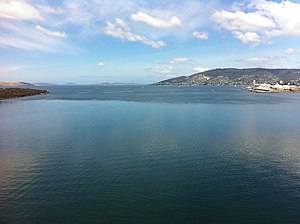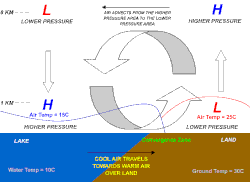

A sea breeze or onshore breeze is any wind that blows from a large body of water toward or onto a landmass. By contrast, a land breeze or offshore breeze is any wind that blows from a landmass toward or onto a large body of water. Sea breezes and land breezes are both important factors in coastal regions' prevailing winds.[1]
Sea breeze and land breeze develop due to differences in air pressure created by the differing heat capacities of water and dry land. As such, sea breezes and land breezes are more localised than prevailing winds. Since land heats up much faster than water under solar radiation, a sea breeze is a common occurrence along coasts after sunrise. On the other hand, dry land also cools faster than water without solar radiation, so the wind instead flows from the land towards the sea when the sea breeze dissipates after sunset.
The land breeze at nighttime is usually shallower than the sea breeze in daytime. Unlike the daytime sea breeze, which is driven by convection, the nighttime land breeze is driven by convergence[definition needed].[citation needed]
The term offshore wind refers to any wind over open water, which is related to but not synonymous with offshore breeze.
- ^ Ackerman, Steve (1995). "Sea and Land Breezes". Cooperative Institute for Meteorological Satellite Studies. University of Wisconsin. Archived from the original on February 13, 2020. Retrieved October 12, 2023.